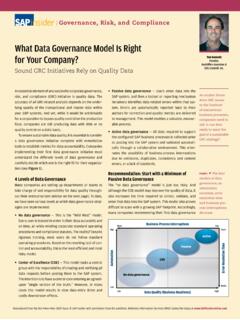Transcription of Today’s shared services operating models: The …
1 IBM global Process ServicesThought Leadership White PaperDecember 2011 today s shared services operating models: The engine behind enterprise transformationLeveraging the power of globally integrated business services2 today s shared services operating models: The engine behind enterprise transformationContents2 today s global marketplace3 The BPO shared - services evolution4 Moving toward globally integrated business services8 The engine of today s globally integrated back office: GIBS10 GIBS benefits11 Getting started11 Let s continue the conversation12 For more informationToday s global marketplaceA slow global economic recovery presents ongoing challenges to businesses of almost every size in virtually every are must find ways to spend less and achieve morewith fewer resources.
2 Within this global arena, competition isarising from every corner of the world but so are opportuni-ties. today s market leaders are recognizing that to succeed inthis new business environment, they must rethink their existingoperational models to better support their strategic they are looking to an operating model that helps create anorganization that can seamlessly connect, interact and respond tocustomers, consumers, suppliers and resources worldwide. Bydoing so, the enterprise is able to take advantage of innovationand globalization and drive integration and value across the busi-ness now and into the s market leaders understand the needto create an integrated organization that canseamlessly connect and interact with as wellas respond to customers, consumers, suppliersand resources to change their operating models is one thing, butachieving this level of transformation is another matter.
3 Itrequires an end-to-end integration that is possible only withrepeatable processes, optimized assets, insightful analysis, skilledresources and integrated operations all occurring on a globalbasis. In addition, transformation requires strong support fromleadership, collaborative governance and common from the 2010 IBM global chief financial officer (CFO)study confirm that many organizations do not have the expertise,technology and innovation in place to achieve rapid end-to-endenterprise study highlights the importanceof leveraging service delivery models that combine internalshared services with outsourcing (referred to in the market as hybrid models ).
4 Companies executing these hybrid models are centrally manag-ing their processes using an end-to-end approach and success-fully accelerating the path of transformation. This approach can result in a more integrated organization that is able to notonly help drive rapid cost savings but also increase agility andbusiness growth. This improved cash flow can fund the cost of transformation while driving ongoing innovation and sustain-able performance improvements that can translate into lastingshareholder value for the entire white paper describes a new model that involves the cre-ation of a single hybrid business unit consisting of internalshared services and external providers of business services .
5 The3 IBM global Process Servicespaper discusses the benefits of this model and provides insightinto key considerations organizations should address whenembarking on this transformation requires end-to-end integration possible only withrepeatable processes, optimized assets, insight-ful analysis, skilled resources and integratedoperations all occurring on a global BPO shared - services evolutionAs information technology, outsourcing providers and the business process outsourcing (BPO) industry itself have greatlymatured over the past decade, shared - services models have beenundergoing their own parallel evolution, as shown in Figure the early 1990s, shared services was a unique operatingmodel in which an internal shared - services organization was setup within the company s primary operations region.
6 This servicecenter was primarily focused on driving cost reduction. Its policy, practice and adoption decisions were determined on abusiness unit or regional basis, with process scope separated into core and non-core processes. Functionally led and governed,this model lacked standard enterprise-wide processes and oper-ated with fragmented technologies and service the late 1990s, companies began to horizontally integratetheir back-office functions by aligning functional activities, head-count and budgets under one worldwide functional leader (forexample, the CFO, the chief human resources officer or thechief procurement officer).
7 At the same time, off-shore capabili-ties began to offer new reduced-cost sourcing options. As aresult, regional centers emerged, with cross-national processeslocated off shore to drive cost reduction and take advantage of anew group of skilled professionals. Simultaneously, this modelsaw greater investment in leading enterprise resource planning(ERP) systems but was still largely functionally led and s next-generation or integrated shared services modelaggregates transactional and common activities across functionsinto a stand-alone globally integrated business services (GIBS)unit.
8 This means creating an entirely new joint hybrid organization (encompassing internal and external providershared services scope) led by a newly created C-level model designed to take service delivery to the nextlevel embraces innovation, end-to-end integration and a trulyglobal perspective. Regardless of where a company is in its evo-lution or whether it is large, small or somewhere in between, aglobal perspective is critical to success in the 21st centurybecause it enables a stronger growth strategy at a pace that is right for that particular business.
9 The GIBS model sets thestage to optimize business processes and better leverage businessinsights that enable enhanced decision making helping to makethe entire business smarter and more s next-generation shared servicesmodel is designed to aggregate transactionaland common activities into a consolidated,stand-alone globally integrated business services (GIBS) s shared services operating models: The engine behind enterprise transformationInternationalMultinational IntegratedSmarterReplicateOffshoreConnec tOptimizeReplicateOffshoreConnectOptimiz e2005 TodayEarly1990sLate1990sIInstrumentedIns trumentedInterconnectedInterconnectedInt elligentIntelligentFigure 1.
10 Globally integrated business services enable the evolution toward smarter organizational models that are more instrumented, interconnectedand toward globally integratedbusiness servicesIn a world that continues to accelerate the pace of change inmost industries, flexibility becomes a competitive a result, many companies are seeking to reach the next level,one that transcends cost benefits to encompass agility, flexibilityand the ability to anticipate and quickly respond to trends, pat-terns and behaviors.






